Chevrolet HHR 2008 Owner's Manual
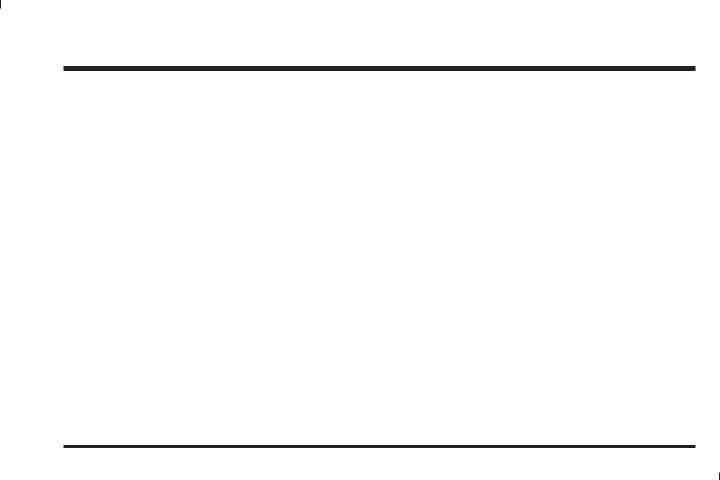
2008 Chevrolet HHR Owner Manual M
Seats and Restraint Systems ........................... |
1-1 |
Front Seats ............................................... |
1-2 |
Rear Seats .............................................. |
1-10 |
Safety Belts ............................................. |
1-12 |
Child Restraints ....................................... |
1-33 |
Airbag System ......................................... |
1-57 |
Restraint System Check ............................ |
1-72 |
Features and Controls ..................................... |
2-1 |
Keys ........................................................ |
2-3 |
Doors and Locks ....................................... |
2-9 |
Windows ................................................. |
2-15 |
Theft-Deterrent Systems ............................ |
2-18 |
Starting and Operating Your Vehicle ........... |
2-21 |
Mirrors .................................................... |
2-39 |
OnStar® System ...................................... |
2-44 |
Storage Areas ......................................... |
2-47 |
Sunroof .................................................. |
2-52 |
Instrument Panel ............................................. |
3-1 |
Instrument Panel Overview .......................... |
3-4 |
Climate Controls ...................................... |
3-23 |
Warning Lights, Gages, and Indicators ........ |
3-28 |
Driver Information Center (DIC) .................. |
3-46 |
Audio System(s) ....................................... |
3-59 |
Driving Your Vehicle ....................................... |
4-1 |
Your Driving, the Road, and Your Vehicle |
..... 4-2 |
Towing ................................................... |
4-32 |
Service and Appearance Care .......................... |
5-1 |
Service ..................................................... |
5-3 |
Fuel ......................................................... |
5-5 |
Checking Things Under the Hood ............... |
5-10 |
Headlamp Aiming ..................................... |
5-43 |
Bulb Replacement .................................... |
5-46 |
Windshield Wiper Blade Replacement ......... |
5-50 |
Tires ...................................................... |
5-52 |
Appearance Care ................................... |
5-110 |
Vehicle Identification ............................... |
5-118 |
Electrical System .................................... |
5-118 |
Capacities and Specifications ................... |
5-125 |
Maintenance Schedule ..................................... |
6-1 |
Maintenance Schedule ............................... |
6-2 |
Customer Assistance Information .................... |
7-1 |
Customer Assistance and Information ........... |
7-2 |
Reporting Safety Defects ........................... |
7-13 |
Vehicle Data Recording and Privacy ........... |
7-16 |
Index ................................................................ |
1 |
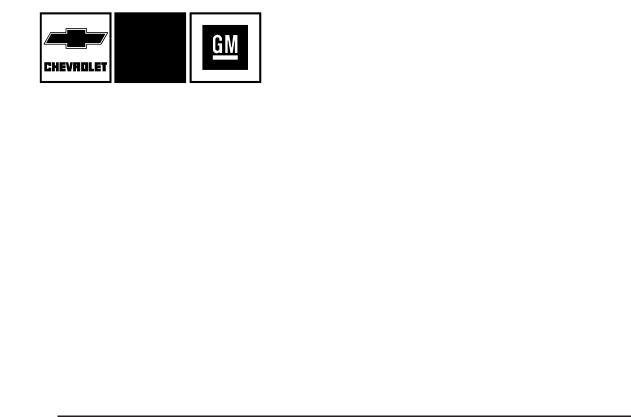
GENERAL MOTORS, GM, the GM Emblem, CHEVROLET, the CHEVROLET Emblem, and the name HHR are registered trademarks of General Motors Corporation.
This manual includes the latest information at the time it was printed. We reserve the right to make changes after that time without further notice. For vehicles first sold in Canada, substitute the name “General Motors of Canada Limited” for Chevrolet Motor Division whenever it appears in this manual.
This manual describes features that may be available in this model, but your vehicle may not have all of them. For example, more than one entertainment system may be offered or your vehicle may have been ordered without a front passenger or rear seats.
Keep this manual in the vehicle for quick reference.
Canadian Owners
A French language copy of this manual can be obtained from your dealer/retailer or from:
Helm, Incorporated
P.O. Box 07130
Detroit, MI 48207
1-800-551-4123 www.helminc.com
Propriétaires Canadiens
On peut obtenir un exemplaire de ce guide en français auprès de concessionnaire ou à l’adresse suivante:
Helm Incorporated
P.O. Box 07130
Detroit, MI 48207
1-800-551-4123 www.helminc.com
Litho in U.S.A. |
© 2007 General Motors Corporation. All Rights Reserved. |
Part No. 15865149 A First Printing |
ii
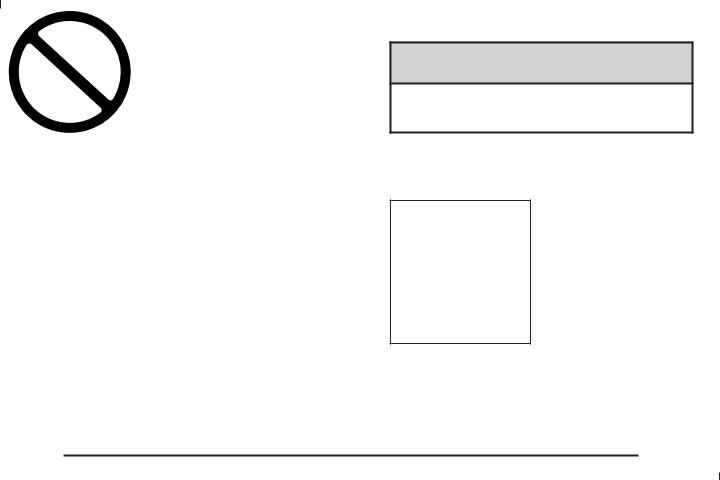
Using this Manual
Many people read the owner manual from beginning to end when they first receive their new vehicle to learn about the vehicle’s features and controls. Pictures
and words work together to explain things.
Index
A good place to quickly locate information about the vehicle is the Index in the back of the manual. It is an alphabetical list of what is in the manual and the page number where it can be found.
Safety Warnings and Symbols
There are a number of safety cautions in this book. A box with the word CAUTION is used to tell about things that could hurt you or others if you were to ignore the warning.
{CAUTION:
These mean there is something that could hurt you or other people.
We tell you what the hazard is and what to do to help avoid or reduce the hazard. Please read these cautions. If you do not, you or others could be hurt.
A circle with a slash through it is a safety symbol which means “Do Not,” “Do Not do this”
or “Do Not let this happen.”
iii

Vehicle Damage Warnings
You will also find notices in this manual.
Notice: These mean there is something that could damage your vehicle.
A notice tells about something that can damage the vehicle. Many times, this damage would not be covered by your vehicle’s warranty, and it could be costly.
The notice tells what to do to help avoid the damage.
When you read other manuals, you might see CAUTION and NOTICE warnings in different colors or in different words.
There are also warning labels on the vehicle which use the same words, CAUTION or NOTICE.
Vehicle Symbols
The vehicle has components and labels that use symbols instead of text. Symbols are shown along with the text describing the operation or information relating to a specific component, control, message, gage, or indicator.
iv
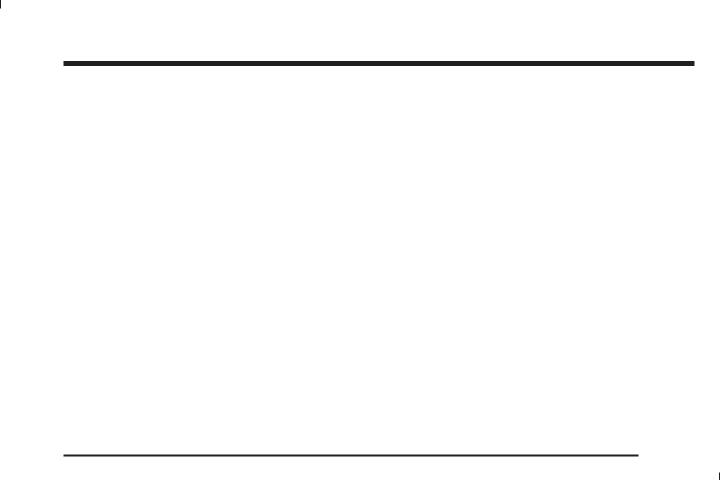
Section 1 Seats and Restraint Systems
Front Seats ...................................................... |
1-2 |
Manual Seats ................................................ |
1-2 |
Seat Height Adjuster ....................................... |
1-3 |
Power Seat ................................................... |
1-3 |
Power Lumbar ............................................... |
1-4 |
Heated Seats ................................................. |
1-4 |
Reclining Seatbacks ........................................ |
1-5 |
Head Restraints ............................................. |
1-7 |
Passenger Folding Seatback ............................ |
1-8 |
Rear Seats ..................................................... |
1-10 |
Split Folding Rear Seat ................................. |
1-10 |
Safety Belts ................................................... |
1-12 |
Safety Belts: They Are for Everyone ................ |
1-12 |
How to Wear Safety Belts Properly ................. |
1-18 |
Lap-Shoulder Belt ......................................... |
1-26 |
Safety Belt Use During Pregnancy .................. |
1-32 |
Safety Belt Extender ..................................... |
1-32 |
Child Restraints ............................................. |
1-33 |
Older Children .............................................. |
1-33 |
Infants and Young Children ............................ |
1-36 |
Child Restraint Systems ................................. |
1-40 |
Where to Put the Restraint ............................. |
1-42 |
Lower Anchors and Tethers for Children |
|
(LATCH) .................................................. |
1-43 |
Securing a Child Restraint in a Rear Seat |
|
Position ................................................... |
1-51 |
Securing a Child Restraint in the Right |
|
Front Seat Position .................................... |
1-53 |
Airbag System ............................................... |
1-57 |
Where Are the Airbags? ................................ |
1-60 |
When Should an Airbag Inflate? ..................... |
1-62 |
What Makes an Airbag Inflate? ....................... |
1-63 |
How Does an Airbag Restrain? ....................... |
1-63 |
What Will You See After an Airbag Inflates? ..... |
1-64 |
Passenger Sensing System ............................ |
1-65 |
Servicing Your Airbag-Equipped Vehicle ........... |
1-70 |
Adding Equipment to Your Airbag-Equipped |
|
Vehicle .................................................... |
1-71 |
Restraint System Check .................................. |
1-72 |
Checking the Restraint Systems ...................... |
1-72 |
Replacing Restraint System Parts After a |
|
Crash ...................................................... |
1-73 |
1-1
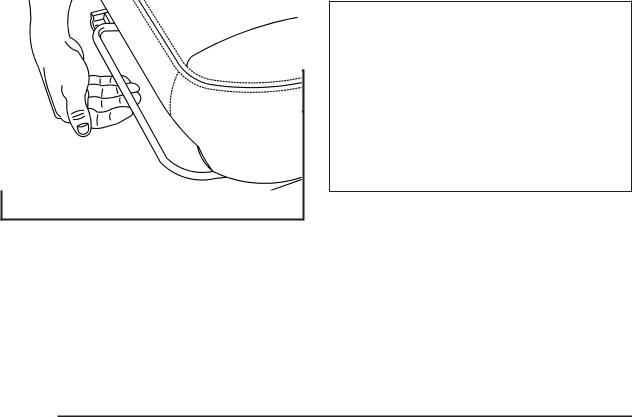
Front Seats
Manual Seats
{CAUTION:
You can lose control of the vehicle if you try to adjust a manual driver’s seat while the vehicle is moving. The sudden movement could startle and confuse you, or make you push a pedal when you do not want to. Adjust the driver’s seat only when the vehicle is not moving.
Lift the bar located under the front of the seat to unlock it. Slide the seat to where you want it and release
the bar. Try to move the seat with your body to be sure the seat is locked in place.
1-2
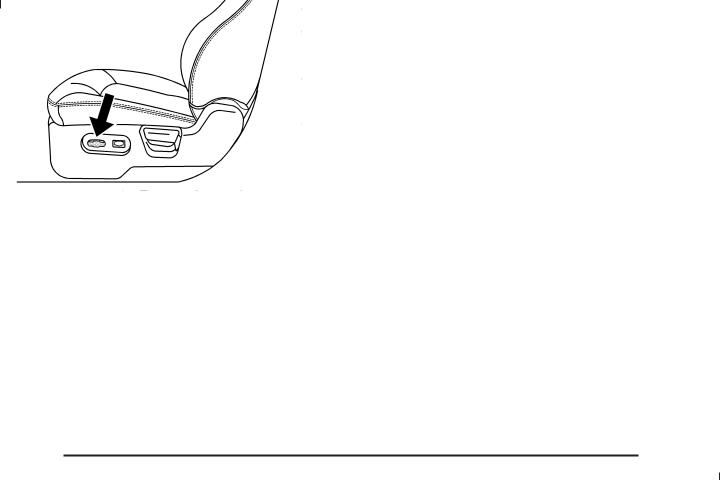
Seat Height Adjuster |
Power Seat |
|
|
|
|
|
|
|
If your vehicle has this feature, the driver’s seat height adjuster is located on the outboard side of the seat.
To raise the seat, move the lever upward repeatedly until the seat is at the desired height. To lower the seat, move the lever downward repeatedly until the seat is
at the desired height.
Driver’s Seat with Power Seat Control and Power Lumbar shown
If the vehicle has a power seat, the control used to operate it is located on the outboard side of the driver’s seat. To adjust the seat, do any of the following:
•Move the seat forward or rearward by sliding the control forward or rearward.
•Raise or lower the front part of the seat cushion by holding the front of the control up or down.
•Raise or lower the entire seat by holding the rear of the control up or down.
1-3
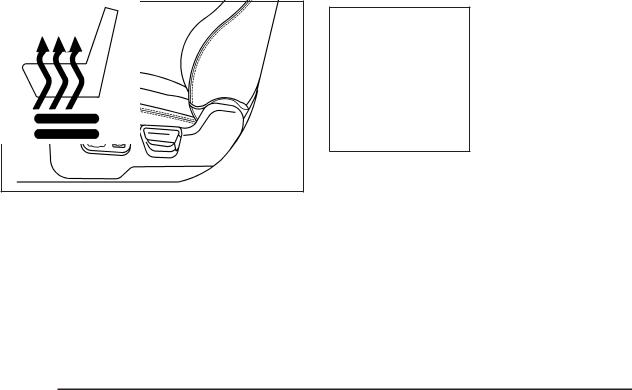
Power Lumbar |
Heated Seats |
If your vehicle has this feature, the control is located on the outboard side of the driver’s seat cushion.
To increase support, press and hold the front of the control. To decrease support, press and hold the rear of the control. Keep in mind that as your seating position changes, as it may during long trips, so should the position of your lumbar support. Adjust the seat
as needed.
If your vehicle has this feature, the driver’s and passenger’s heated seat buttons are located on the climate control
panel below the fan switch.
Driver’s side button shown, Passenger’s side button similar
Press the button once to turn the heated seat to the high setting. Both lights below the heated seat symbol will come on. Press the button a second time and
the heated seat will go to the low setting. The bottom light will come on to indicate that the setting is on low. Press the button a third time to turn the heated seat off.
The heated seat feature will need to be turned on each time the ignition is turned off and back on again.
1-4
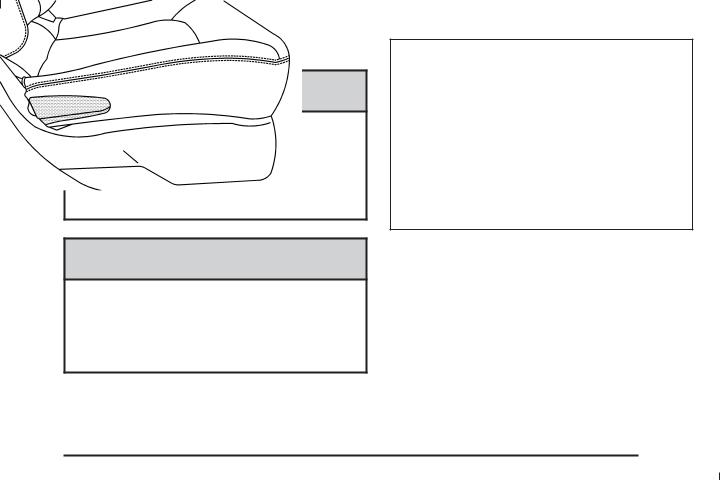
Reclining Seatbacks
{CAUTION:
You can lose control of the vehicle if you try to adjust a manual driver’s seat while the vehicle is moving. The sudden movement could startle and confuse you, or make you push a pedal when you do not want to. Adjust the driver’s seat only when the vehicle is not moving.
{CAUTION:
If the seatback is not locked, it could move forward in a sudden stop or crash. That could cause injury to the person sitting there. Always push and pull on the seatback to be sure it is locked.
Passenger’s Side Reclining Lever shown, Driver’s Side similar
The seats have reclining seatbacks. The lever used to operate them is located on the outboard side of the seats. Lift the lever to release the seatback. Move the seatback to where you want it and release the lever to lock the seatback in place. Press rearward on
the seatback to be sure it is locked into place.
1-5
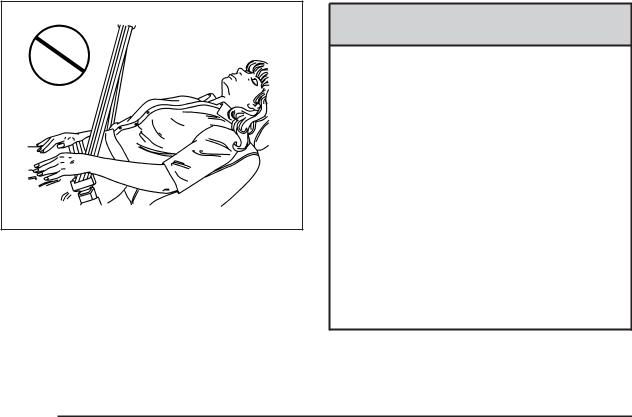
{CAUTION:
Sitting in a reclined position when your vehicle is in motion can be dangerous. Even if you buckle up, your safety belts cannot do their job when you are reclined like this.
The shoulder belt cannot do its job because it will not be against your body. Instead, it will be in front of you. In a crash, you could go into it, receiving neck or other injuries.
The lap belt cannot do its job either. In a crash, the belt could go up over your abdomen. The belt forces would be there, not at your pelvic bones. This could cause serious internal injuries.
For proper protection when the vehicle is in motion, have the seatback upright. Then sit well back in the seat and wear your safety belt properly.
Do not have a seatback reclined if your vehicle is moving.
1-6
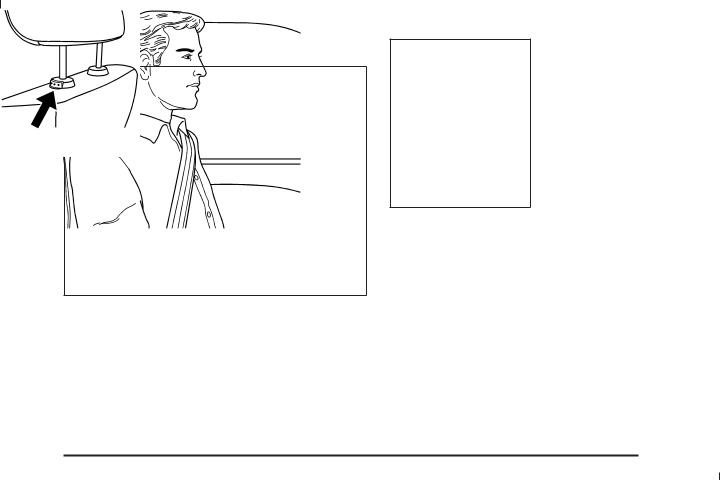
Head Restraints
Adjust the head restraint so that the top of the restraint is at the same height as the occupant’s head. This position reduces the chance of a neck injury in a crash.
Pull the head restraint up to raise it. To lower the head restraint, press
the button, located on the top of the seatback,
and push the restraint down. Only the front head restraints are adjustable.
Both the front and rear head restraints can be removed. Press the button, located on the top of the seatback, and pull the restraint out from the seatback. Do
not remove the head restraint if someone will be sitting in that seat while the vehicle is moving.
1-7
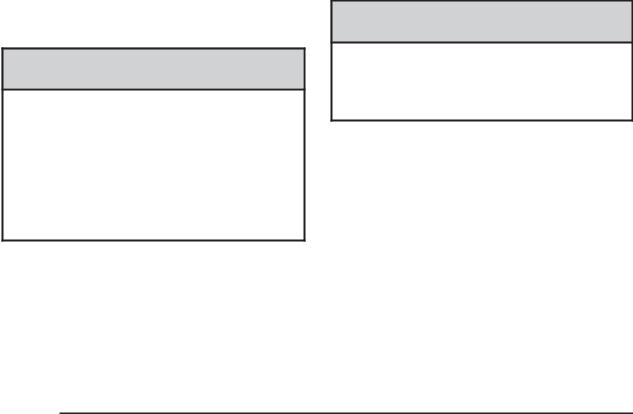
Passenger Folding Seatback
Your vehicle has a front passenger seat that folds flat.
{CAUTION:
If you fold the seatback forward to carry longer objects, such as skis, be sure any such cargo is not near an airbag. In a crash, an inflating airbag might force that object toward a person. This could cause severe injury or even death. Secure objects away from the area in which an airbag would inflate. For more information, see
Where Are the Airbags? on page 1-60 and Loading Your Vehicle on page 4-27.
{CAUTION:
Things you put on this seatback can strike and injure people in a sudden stop or turn, or in a crash. Remove or secure all items before driving.
To fold the seatback, do the following:
1.Move the front passenger seat rearward to ensure there is enough room to fold the seatback forward. See Manual Seats on page 1-2 for more information. The head restraint may need to be removed if the seat is not able to be moved
fully rearward. If removing the head restraint, store it so that it will not move while the vehicle is in motion.
2.Make sure that the seatback is in an upright position. Use the recliner lever located on the outboard side of the seat to move the seatback to the upright position.
1-8
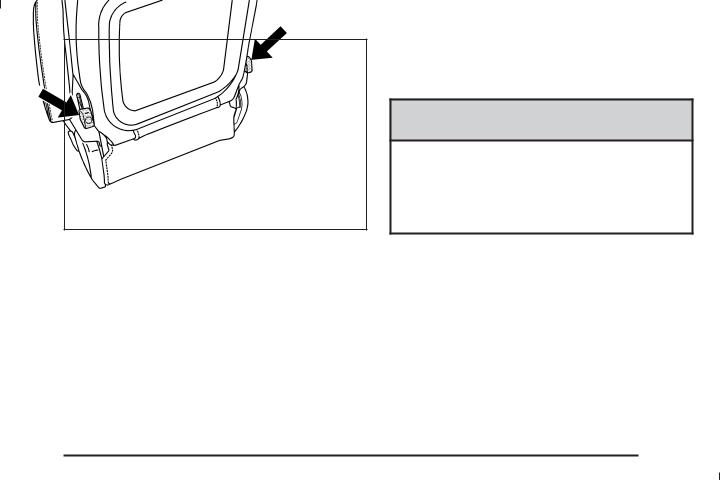
3.To fold the seat flat, pull up on either lever located toward the rear of the seatback. Fold the seat forward until the seatback disengages.
4.Continue to fold the seat forward until it locks in the folded position. Pull up on the seatback to be sure it is locked.
To raise the seatback to an upright position:
1.Pull up on either lever.
2.Push the seatback up until it is in a locked position.
{CAUTION:
If the seatback is not locked, it could move forward in a sudden stop or crash. That could cause injury to the person sitting there. Always push and pull on the seatback to be sure it is locked.
3.Push and pull on the seatback to make sure it is locked.
1-9
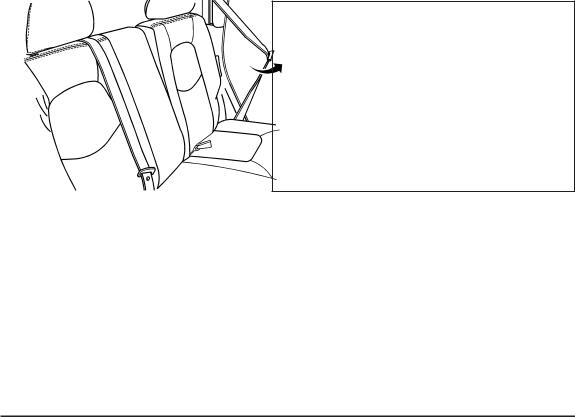
Rear Seats
Split Folding Rear Seat
The seatbacks can be folded flat.
To lower the rear seatback(s):
1.Move the front seat forward and/or put the front seatback in an upright position so it does not interfere with folding the rear seatback forward.
2.Open the rear door while the vehicle is parked.
3.The rear head restraint may need to be removed if it interferes with the front seat when the front seat is moved back in place. If removed, store the head restraint where it cannot move while the vehicle is in motion.
Notice: Folding a rear seat with the safety belts still fastened may cause damage to the seat or the safety belts. Always unbuckle the safety belts and return them to their normal stowed position before folding a rear seat.
4.Move the safety belt out of the way before lowering the seatback. Do not let the safety belt get caught between the seatback and seat cushion as the seatback is folded.
1-10
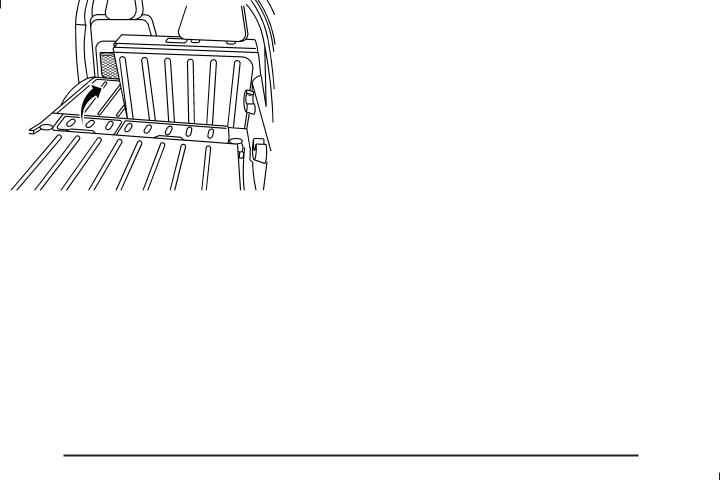
|
5. Pull up on the knob |
To raise the rear seatback(s): |
|
|
located on the top of |
|
|
|
the seatback on |
|
{CAUTION: |
|
the outboard side to |
|
|
|
release the seatback. |
|
|
|
|
|
A safety belt that is improperly routed, not |
|
|
|
properly attached, or twisted will not provide |
|
|
|
the protection needed in a crash. The person |
|
|
|
wearing the belt could be seriously injured. |
|
|
|
After raising the rear seatback, always check |
|
|
|
to be sure that the safety belts are properly |
|
|
|
routed and attached, and are not twisted. |
|
|
|
|
|
|
|
|
|
|
|
1. Lift the seatback up and push rearward until you |
|
|
|
hear a click. Keep the safety belt clear of the seat |
|
|
|
and not twisted. |
|
|
|
The release knob on the top of the seatback has a |
|
|
|
red ring. If the seatback is not fully latched this |
|
|
|
ring will be visible. Push on the seatback until the |
|
|
|
ring is not visible. |
|
|
|
|
1-11
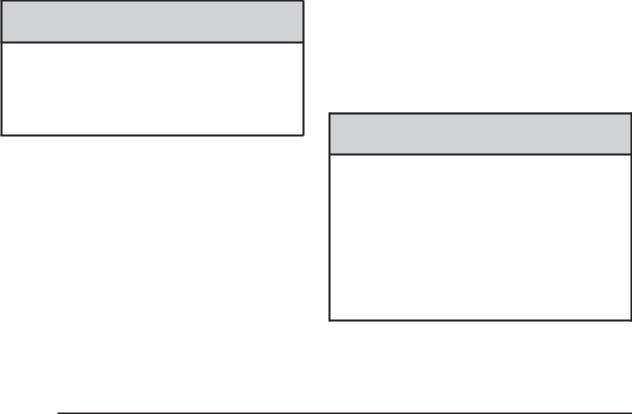
{CAUTION:
If the seatback is not locked, it could move forward in a sudden stop or crash. That could cause injury to the person sitting there. Always pull forward on the top of the seatback at the area of the latch to be sure it is locked.
2.Push and pull on the seatback to make sure it is locked in place.
Safety Belts
Safety Belts: They Are for Everyone
This part of the manual tells you how to use safety belts properly. It also tells you some things you should not do with safety belts.
{CAUTION:
Do not let anyone ride where he or she cannot wear a safety belt properly. If you are in a crash and you are not wearing a safety belt, your injuries can be much worse. You can hit things inside the vehicle harder or be ejected from it and be seriously injured or killed. In the same crash, you might not be, if you are buckled up. Always fasten your safety belt, and check that your passenger(s) are restrained properly too.
1-12
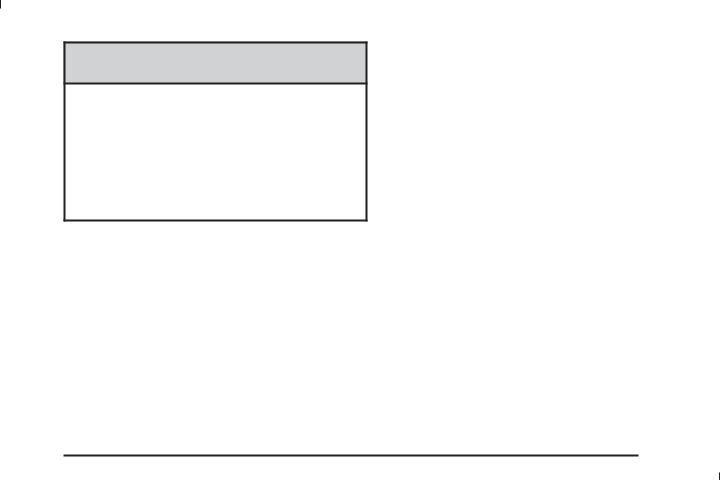
{CAUTION:
It is extremely dangerous to ride in a cargo area, inside or outside of a vehicle. In a collision, people riding in these areas are more likely to be seriously injured or killed. Do not allow people to ride in any area of your vehicle that is not equipped with seats and safety belts. Be sure everyone in your vehicle is in a seat and using a safety belt properly.
Your vehicle has indicators as a reminder to buckle your safety belts. See Safety Belt Reminders on page 3-30.
In most states and in all Canadian provinces, the law requires wearing safety belts. Here is why:
You never know if you will be in a crash. If you do have a crash, you do not know if it will be a serious one.
A few crashes are mild, and some crashes can be so serious that even buckled up, a person would not survive. But most crashes are in between. In many of them, people who buckle up can survive and sometimes walk away. Without belts they could have been badly hurt or killed.
After more than 40 years of safety belts in vehicles, the facts are clear. In most crashes buckling up does matter... a lot!
1-13
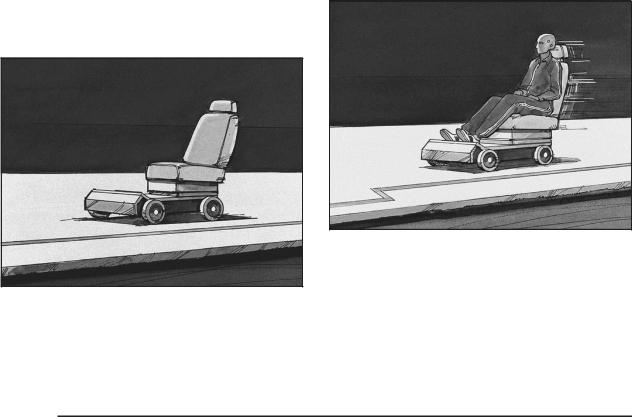
Why Safety Belts Work
When you ride in or on anything, you go as fast as it goes.
Put someone on it.
Take the simplest vehicle. Suppose it is just a seat on wheels.
1-14
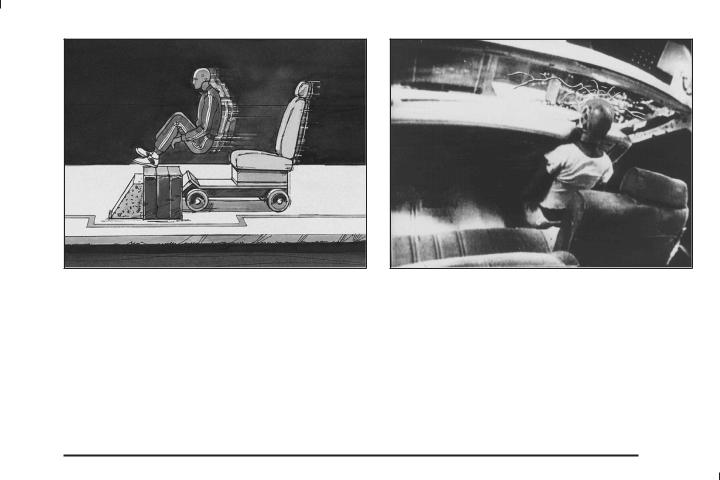
Get it up to speed. Then stop the vehicle. The rider does not stop.
The person keeps going until stopped by something. In
a real vehicle, it could be the windshield...
1-15
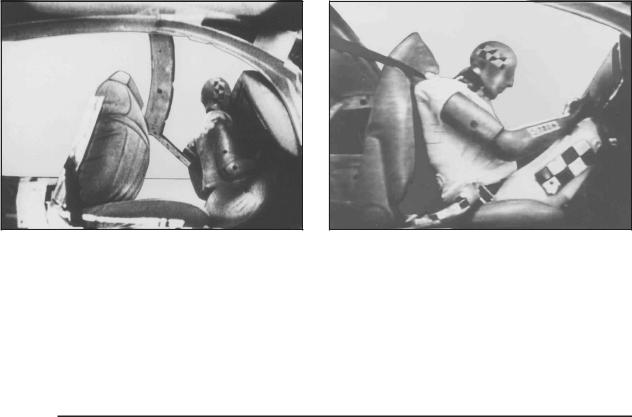
or the instrument panel... |
or the safety belts! |
|
With safety belts, you slow down as the vehicle does. |
|
You get more time to stop. You stop over more distance, |
|
and your strongest bones take the forces. That is why |
|
safety belts make such good sense. |
1-16

Questions and Answers About
Safety Belts
Q: Will I be trapped in the vehicle after a crash if I am wearing a safety belt?
A: You could be — whether you are wearing a safety belt or not. But your chance of being conscious during and after an accident, so you can unbuckle and get out, is much greater if you are belted.
And you can unbuckle a safety belt, even if you are upside down.
Q: If my vehicle has airbags, why should I have to wear safety belts?
A: Airbags are supplemental systems only; so they work with safety belts — not instead of them. Whether or not an airbag is provided, all occupants still have to buckle up to get the most protection. That is true not only in frontal collisions, but especially in side and other collisions.
Q: If I am a good driver, and I never drive far from home, why should I wear safety belts?
A: You may be an excellent driver, but if you are in a crash — even one that is not your fault — you and your passenger(s) can be hurt. Being a good
driver does not protect you from things beyond your control, such as bad drivers.
Most accidents occur within 25 miles (40 km) of home. And the greatest number of serious injuries and deaths occur at speeds of less than 40 mph (65 km/h).
Safety belts are for everyone.
1-17
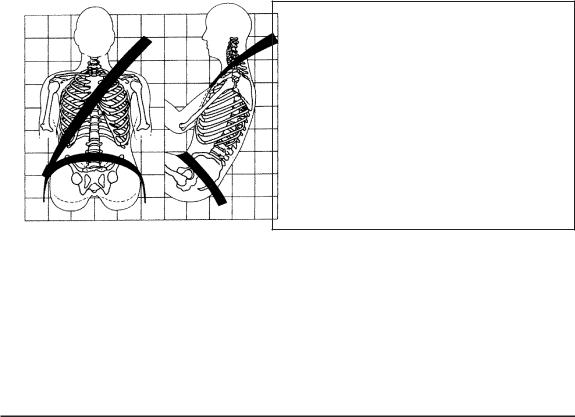
How to Wear Safety Belts Properly
This section is only for people of adult size.
Be aware that there are special things to know about safety belts and children. And there are different rules for smaller children and babies. If a child will be
riding in your vehicle, see Older Children on page 1-33 or Infants and Young Children on page 1-36. Follow those rules for everyone’s protection.
It is very important for all occupants to buckle up. Statistics show that unbelted people are hurt more often in crashes than those who are wearing safety belts.
Occupants who are not buckled up can be thrown out of the vehicle in a crash. And they can strike others in
the vehicle who are wearing safety belts.
First, before you or your passenger(s) wear a safety belt, there is important information you should know.
1-18
Sit up straight and always keep your feet on the floor in front of you. The lap part of the belt should be worn low and snug on the hips, just touching the thighs. In a crash, this applies force to the strong pelvic bones and you would be less likely to slide under the lap belt. If you slid under it, the belt would apply force on your abdomen. This could cause serious or even fatal injuries. The shoulder belt should go over the shoulder and across the chest. These parts of the body are best able to take belt restraining forces.
The shoulder belt locks if there is a sudden stop or crash.
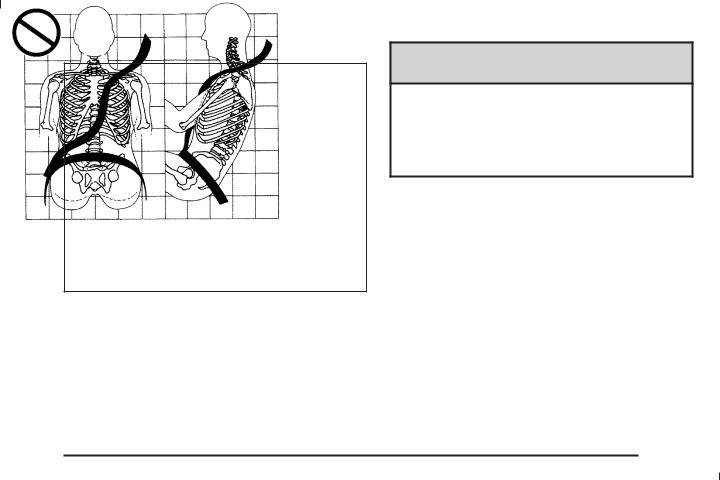
Q: What is wrong with this?
A: The shoulder belt is too loose. It will not give nearly as much protection this way.
{CAUTION:
You can be seriously hurt if your shoulder belt is too loose. In a crash, you would move forward too much, which could increase injury. The shoulder belt should fit snugly against your body.
1-19
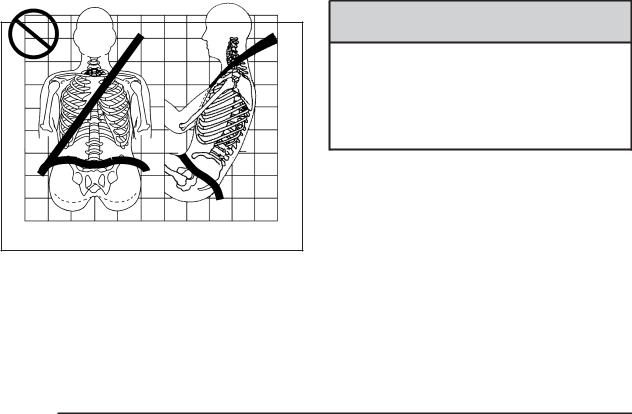
Q: What is wrong with this?
A: The lap belt is too loose. It will not give as much protection this way.
{CAUTION:
You can be seriously hurt if your lap belt is too loose. In a crash, you could slide under the lap belt and apply force on your abdomen. This could cause serious or even fatal injuries. The lap belt should be worn low and snug on the hips, just touching the thighs.
1-20
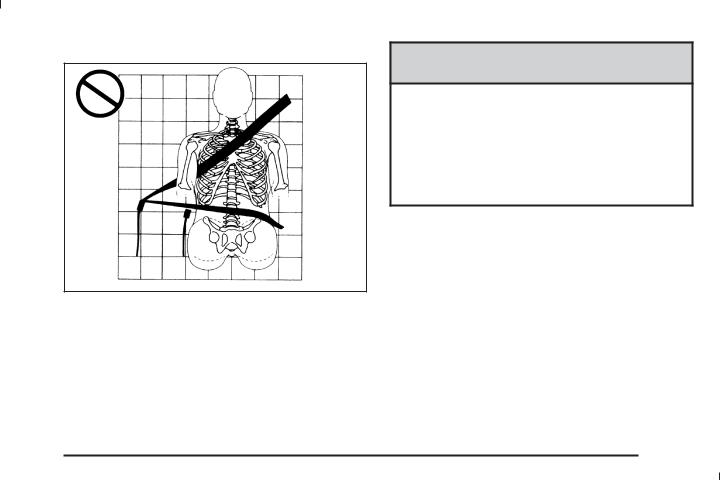
Q: What is wrong with this?
A: The belt is buckled in the wrong place.
{CAUTION:
You can be seriously injured if your belt is buckled in the wrong place like this. In a crash, the belt would go up over your abdomen. The belt forces would be there, not on the pelvic bones. This could cause serious internal injuries. Always buckle your belt into the buckle nearest you.
1-21
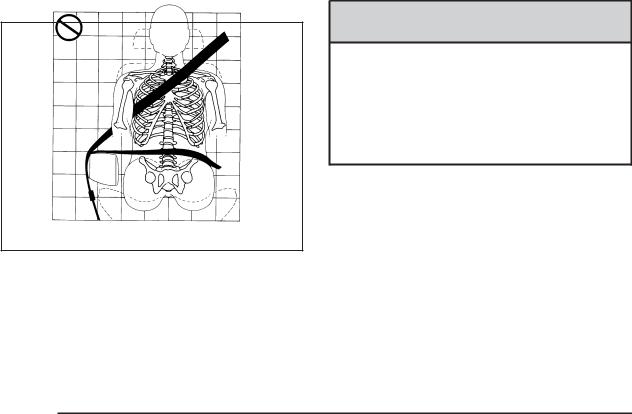
Q: What is wrong with this?
{CAUTION:
You can be seriously injured if your belt goes over an armrest like this. The belt would be much too high. In a crash, you can slide under the belt. The belt force would then be applied on the abdomen, not on the pelvic bones, and that could cause serious or fatal injuries. Be sure the belt goes under the armrests.
A: The belt is over an armrest.
1-22
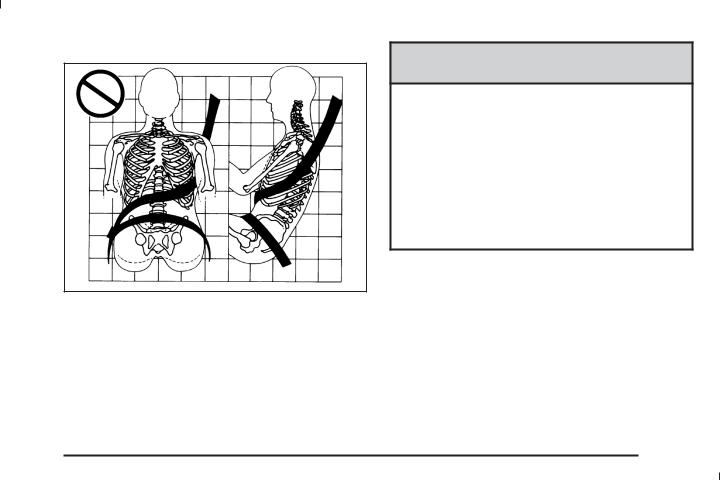
Q: What is wrong with this?
A: The shoulder belt is worn under the arm. It should be worn over the shoulder at all times.
{CAUTION:
You can be seriously injured if you wear the shoulder belt under your arm. In a crash, your body would move too far forward, which would increase the chance of head and neck injury. Also, the belt would apply too much force to the ribs, which are not as strong as shoulder bones. You could also severely injure internal organs like your liver or spleen. The shoulder belt should go over the shoulder and across the chest.
1-23
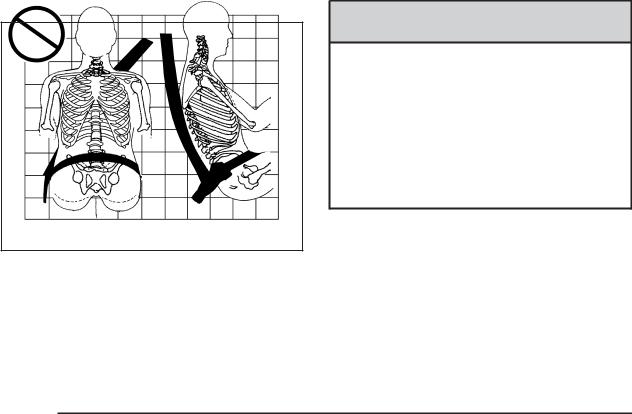
Q: What is wrong with this?
{CAUTION:
You can be seriously injured by not wearing the lap-shoulder belt properly. In a crash, you would not be restrained by the shoulder belt. Your body could move too far forward increasing the chance of head and neck injury. You might also slide under the lap belt. The belt force would then be applied right on the abdomen. That could cause serious or fatal injuries. The shoulder belt should go over the shoulder and across the chest.
A: The belt is behind the body.
1-24
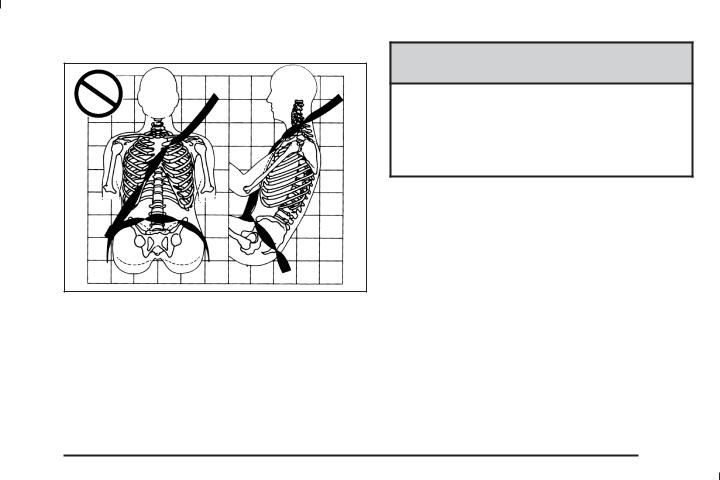
Q: What is wrong with this?
A: The belt is twisted across the body.
{CAUTION:
You can be seriously injured by a twisted belt. In a crash, you would not have the full width of the belt to spread impact forces. If a belt is twisted, make it straight so it can work properly, or ask your dealer/retailer to fix it.
1-25

Lap-Shoulder Belt
All seating positions in your vehicle have a lap-shoulder belt.
Here is how to wear a lap-shoulder belt properly.
1.Adjust the seat, if the seat is adjustable, so you can sit up straight. To see how, see “Seats” in the Index.
2.Pick up the latch plate and pull the belt across you. Do not let it get twisted.
The lap-shoulder belt may lock if you pull the belt across you very quickly. If this happens, let the belt go back slightly to unlock it. Then pull the belt across you more slowly.
If you ever pull the shoulder portion of a passenger belt out all the way, you may engage the child restraint locking feature. If this happens, just let the belt go back all the way and start again.
Engaging the child restraint locking feature may affect the passenger sensing system. See
Passenger Sensing System on page 1-65.
1-26
3.Push the latch plate into the buckle until it clicks.
Pull up on the latch plate to make sure it is secure. If the belt is not long enough, see Safety Belt Extender on page 1-32.
Make sure the release button on the buckle is positioned so you would be able to unbuckle the safety belt quickly if necessary.
4.If equipped with a shoulder belt height adjuster, move it to the height that is right for you. Improper shoulder belt height adjustment could reduce
the effectiveness of the safety belt in a crash. See “Shoulder Belt Height Adjustment” later in this section.
